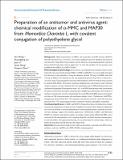Preparation of an antitumor and antivirus agent: chemical modification of α-MMC and MAP30 from Momordica Charantia L. with covalent conjugation of polyethyelene glycol
Author(s)
Zhao, Xiaojun; Meng, Yao; Liu, Shuangfeng; Li, Juan; Meng, Yanfa
DownloadMeng-2012-Preparation of an an.pdf (1.813Mb)
PUBLISHER_CC
Publisher with Creative Commons License
Creative Commons Attribution
Terms of use
Metadata
Show full item recordAbstract
Background: Alpha-momorcharin (α-MMC) and momordica anti-HIV protein (MAP30) derived from Momordica charantia L. have been confirmed to possess antitumor and antivirus activities due to their RNA-N-glycosidase activity. However, strong immunogenicity and short plasma half-life limit their clinical application. To solve this problem, the two proteins were modified with (mPEG)[subscript 2]-Lys-NHS (20 kDa).
Methodology/principal findings: In this article, a novel purification strategy for the two main type I ribosome-inactivating proteins (RIPs), α-MMC and MAP30, was successfully developed for laboratory-scale preparation. Using this dramatic method, 200 mg of α-MMC and about 120 mg of MAP30 was obtained in only one purification process from 200 g of Momordica charantia seeds. The homogeneity and some other properties of the two proteins were assessed by gradient SDS-PAGE, electrospray ionization quadruple mass spectrometry, and N-terminal sequence analysis as well as Western blot. Two polyethylene glycol (PEG)ylated proteins were synthesized and purified. Homogeneous mono-, di-, or tri-PEGylated proteins were characterized by matrix-assisted laser desorption ionization-time of flight mass spectrometry. The analysis of antitumor and antivirus activities indicated that the serial PEGylated RIPs preserved moderate activities on JAR choriocarcinoma cells and herpes simplex virus-1. Furthermore, both PEGylated proteins showed about 60%–70% antitumor and antivirus activities, and at the same time decreased 50%–70% immunogenicity when compared with their unmodified counterparts.
Conclusion/significance: α-MMC and MAP30 obtained from this novel purification strategy can meet the requirement of a large amount of samples for research. Their chemical modification can solve the problem of strong immunogenicity and meanwhile preserve moderate activities. All these findings suggest the potential application of PEGylated α-MMC and PEGylated MAP30 as antitumor and antivirus agents. According to these results, PEGylated RIPs can be constructed with nanomaterials to be a targeting drug that can further decrease immunogenicity and side effects. Through nanotechnology we can make them low-release drugs, which can further prolong their half-life period in the human body.
Date issued
2012-06Department
Massachusetts Institute of Technology. Center for Biomedical EngineeringJournal
International Journal of Nanomedicine
Publisher
Dove Medical Press
Citation
Meng, Yao, Shuanfeng Liu, Juan Li, Yanfa Meng, and Xiaojun Zhao. “Preparation of an Antitumor and Antivirus Agent: Chemical Modification of α-MMC and MAP30 from Momordica Charantia L. with Covalent Conjugation of Polyethyelene Glycol.” International Journal of Nanomedicine (June 2012): 3133.
Version: Final published version
ISSN
1178-2013
1176-9114